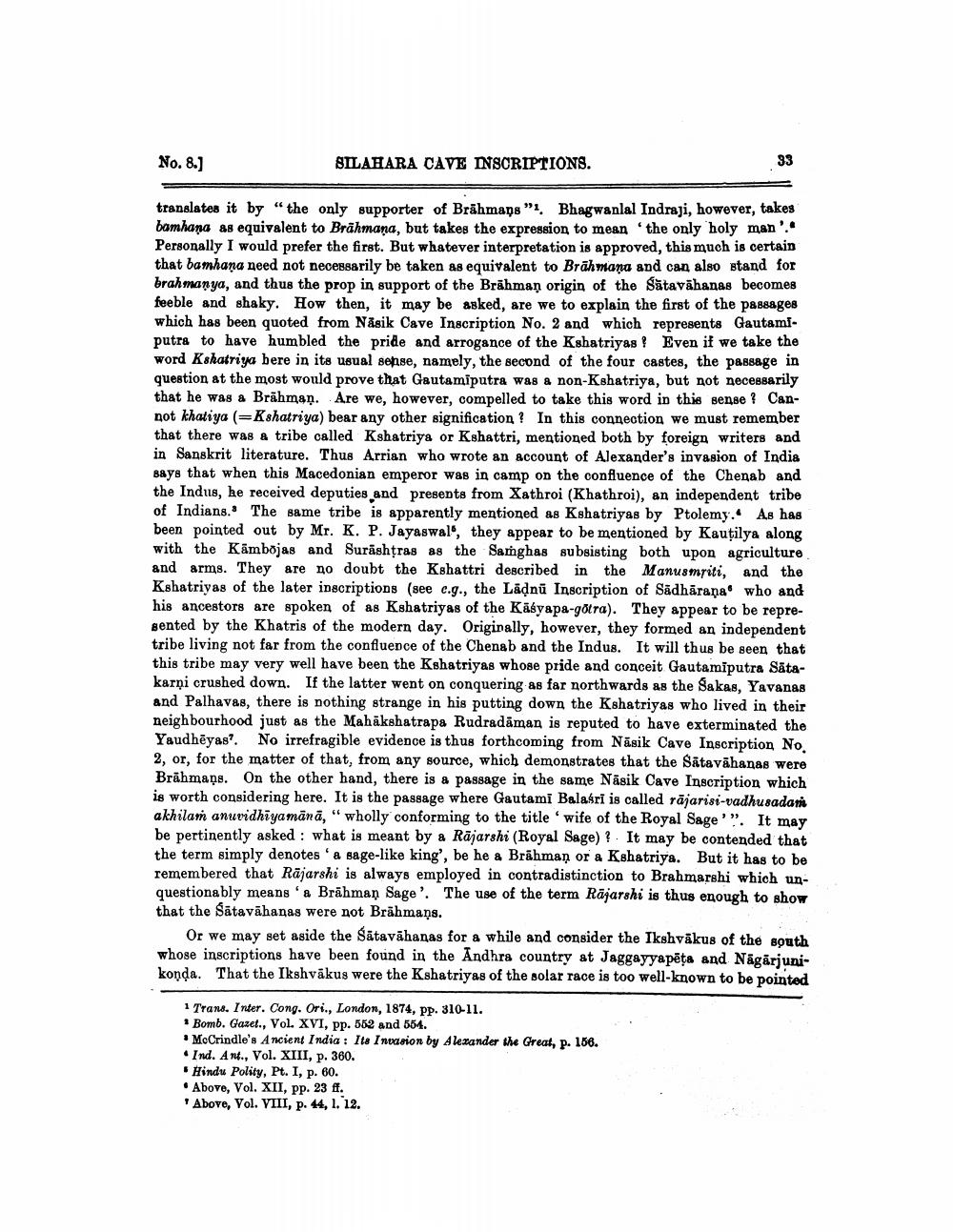________________
No. 8.]
SILAHARA CAVE INSCRIPTIONS.
translates it by “the only supporter of Brāhmaps". Bhagwanlal Indraji, however, takes bamhaņa as equivalent to Brāhmana, but takes the expression to mean the only holy man'." Personally I would prefer the first. But whatever interpretation is approved, this much is certain that bamhana need not necessarily be taken as equivalent to Brāhmand and can also stand for brahmanya, and thus the prop in support of the Brāhmaṇ origin of the Sātavāhanas becomes feeble and shaky. How then, it may be asked, are we to explain the first of the passages which has been quoted from Näsik Cave Inscription No. 2 and which represents Gautamiputra to have humbled the pride and arrogance of the Kshatriyas Even if we take the word Kshatriya bere in its usual sense, namely, the second of the four castes, the passage in question at the most would prove that Gautamiputra was a non-Kshatriya, but not necessarily that he was a Brāhmaṇ. Are we, however, compelled to take this word in this sense ? Cannot khatiya (=Kshatriya) bear any other signification? In this connection we must remember that there was a tribe called Kshatriya or Kshattri, mentioned both by foreign writers and in Sanskrit literature. Thus Arrian who wrote an account of Alexander's invasion of India says that when this Macedonian emperor was in camp on the confluence of the Chenab and the Indus, he received deputies and presents from Xathroi (Khathroi), an independent tribe of Indians. The same tribe is apparently mentioned as Kshatriyas by Ptolemy.. As has been pointed out by Mr. K. P. Jayaswal', they appear to be mentioned by Kautilya along with the Kambojas and Surashtras as the Samghas subsisting both upon agriculture and arms. They are no doubt the Kshattri described in the Manusmriti, and the Kshatriyas of the later inscriptions (see c.g., the Lädnü Inscription of Sädhārana who and his ancestors are spoken of as Kshatriyas of the Käsyapa-gotra). They appear to be represented by the Khatris of the modern day. Originally, however, they formed an independent tribe living not far from the confluence of the Chenab and the Indus. It will thus be seen that this tribe may very well have been the Kshatriyas whose pride and conceit Gautamiputra Sätekarņi crushed down. If the latter went on conquering as far northwards as the Sakas, Yavanas and Palhavas, there is nothing strange in his putting down the Kshatriyas who lived in their neighbourhood just as the Mahākshatrapa Rudradāman is reputed to have exterminated the Yaudhēyas?. No irrefragible evidence is thus forthcoming from Nāsik Cave Inscription No. 2. or. for the matter of that, from any source, which demonstrates that the Satavāhanas were Brāhmaṇs. On the other hand, there is a passage in the same Nāsik Cave Inscription which is worth considering here. It is the passage where Gautami Balasri is called rājarisi-vadhusadan akhilam anuvidhiyamānā, "wholly conforming to the title wife of the Royal Sage'". It may be pertinently asked : what is meant by a Rājarshi (Royal Sage)? - It may be contended that the term simply denotes 'a sage-like king', be he a Brāhman or a Kshatriya. But it has to be remembered that Rājarshi is always employed in contradistinction to Brahmarshi which unquestionably means 'a Brāhman Sage'. The use of the term Räjarshi is thus enough to show that the Sātavāhanas were not Brāhmans.
Or we may set aside the Sātavāhanas for a while and consider the Ikshvākus of the south whose inscriptions have been found in the Andhra country at Jaggayyapēta and Nagarjunikonda. That the Ikshvākus were the Kshatriyas of the solar race is too well-known to be pointed
1 Trans. Inter. Cong. Ori., London, 1874, PP. 310-11. * Bomb. Gazet., Vol. XVI, pp. 552 and 564. • McCrindle's Ancient India : Its Invasion by Alexander the Great, p. 106. • Ind. Ant., Vol. XIII, p. 360.
Hindu Polity, Pt. I, p. 60. . Above, Vol. XII, pp. 23 ff. * Above, Vol. VIII, p. 44, 1. 12.




